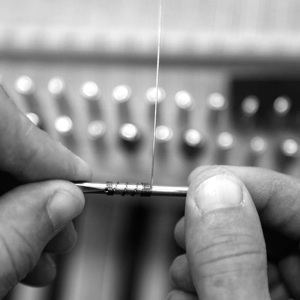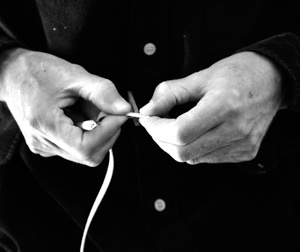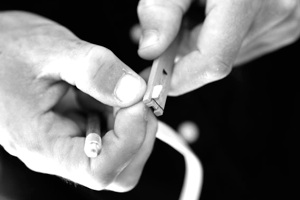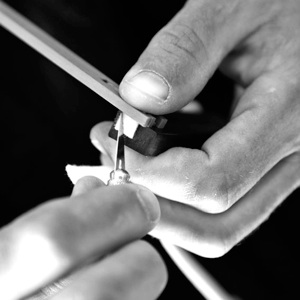CHANGING A STRING

The strings I use in my instruments are (with few exceptions) made by Malcolm Rose.
To change a string you have to take out the tuning pin.
Before you begin it is good practice to wash your hands with soap to avoid making the pin greasy which would probably result in a jerky tuning pin after you put it back. (don´t worry if it happened; it will disappear after some time). If you put talcum powder on your hands and the tuning pin you can be assured of a smooth turning pin after it is put back.
The tuning pins can be taken out of the instrument either by pulling or by turning, depending whether they have a thread or not. The ones I use normally come from Marc Vogel and have a very fine thread. You have to turn (many turns) till the pin is completely lose and up.
In your stringing list you can find the material and diameter of the replacement string. To download the stringing list please see ¨Maintenance¨.
For spare strings you can contact me or Marc Vogel (he also sells a handy ¨string looping device¨ to make the loop on the string).
Hitch the string on its hitchpin and clip it off: in the bass about 12 cm from the name-board, in the treble about 20 cm.
Look at the neighbor pins and copy the way they are spun:
-
‣ hold the tuning pin horizontally and put the end of the string in the hole

-
‣ with both hands holding the tuning pin horizontally, turn it to make the first couple of windings next to the hole
-
‣ angle the tuning pin in the horizontal plane to make the open windings. By now you are approaching the hole in the pin-block.
-
‣ end with some closed windings till you reach the hole in the pin-block
-
‣ with the tuning pin in your hand always keep tension on the string
-
‣ the total length of all the windings together should be more or less the same as on the neighbor pins
-
‣ put the tuning pin in its hole and hit it with a hammer till you reach about the height of its neighbors
-
‣ turn the tuning pin with the tuning hammer; if it goes too light hit it once or twice more
If the same string keeps breaking replace it for a string a gauge thinner. In case you have breaking problems at the change over: brass - iron (tenor area of the harpsichord) replace the last brass string for a thick iron one. Remember that the short 8´ string has about a semitone less tension than the long 8´ string. It is the long one that will break more easily (and it is the diameter or material of the long one you want to change, if necessary)
CHANGING A DAMPER
Historically the dampers of a register that is in off position should be free from the strings to allow for sympathetic resonance. This is achieved by cutting the underside of the damper under an angle. This kind of damper requires a damper-slot that surpasses the level of the plectrum. (not all jacks, including mine many years ago, have such a deep damper-slot).
If your damper-slot stops at the level of the plectrum you either leave the damper square or have a harpsichord maker make the slots deeper.




To put a damper in a jack I push the jack to my belly with the stretched damper felt. It is easier if you enter the damper-slot at an angle (see picture).
Keep pushing till the felt almost reaches the bottom of the slot.
Pull the felt to the front till the end is flush with the back of the jack.
Cut the felt to length (at bit more than the length of the plectrum).
I use a cutting block with a slot that gives place for the plectrum - voicing_tools.jpg
Now cut the angle to the damper and place the jack in the instrument.
-
‣ play the key and see if the damper works
-
‣ if the note doesn´t repeat: raise the damper by sliding it up in its slot, using pliers (as in voicing_tools.jpg)
-
‣ if the note doesn´t damp: lower the damper
-
‣ check if the end of the damper is still flush with the back a of the jack (if not, push it back using pliers)
-
‣ check if the damper touches the neighbor string. If so: cut it shorter using the cutting block